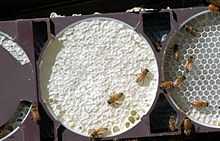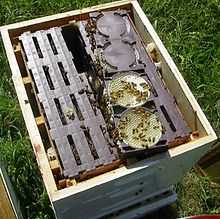Comb honey

Comb honey is honey, intended for consumption, which still contains pieces of the hexagonal-shaped beeswax cells of the honeycomb.
Before the invention of the honey extractor almost all honey produced was in the form of comb honey. Today, most honey is produced for extraction but comb honey remains popular among consumers both for eating 'as is' and for combining with extracted honey to make Chunk Honey. Hobbyists and sideliners can best develop their beekeeping skills by producing comb honey, which they can easily sell for several times its value as extracted honey. Comb honey production is more suitable for areas with a prolonged honeyflow from dutch clover, alsike, and yellow clover. Wooded areas are not very suitable for comb honey production, as bees tend to collect much more propolis, which makes the harvesting of comb honey much more difficult. This problem has been largely circumvented with the adoption of specialized frames which prevent accumulation of propolis on saleable units.
Hive management

Populous honey bee colonies are usually reduced to single hive bodies at the beginning of the honeyflow when one or more comb honey supers are added. Comb honey can either be produced in wooden sections, shallow frames, or Ross Rounds. The successful production of comb honey requires that the hive remain somewhat crowded without overcrowding, which leads to swarming. Young prolific queens help rapid colony population expansion with less likelihood of swarming. Caucasian Apis mellifera bees are often preferred for their tendency to keep a constricted brood nest and for their production of white wax cappings, making more attractive honey combs.
References
- The Hive and the Honeybee, Chapter 16 The Production of Comb and Bulk Comb Honey by Carl E. Killion, 1975 published by Dadant & Sons
- The New Comb Honey Book, by Richard Taylor, 1981, Linden Books
- Honey in the Comb by Eugene Killion, 1981, Dadant & Sons